Katsu curry is just a variation of Japanese curry with a chicken cutlet on top. I used a store-bought block of Japanese curry roux which is commonly used in Japanese households. Chicken Cutlet (Japanese version of chicken schnitzel) brings the Japanese curry up to the next level. It’s so delicious and filling.
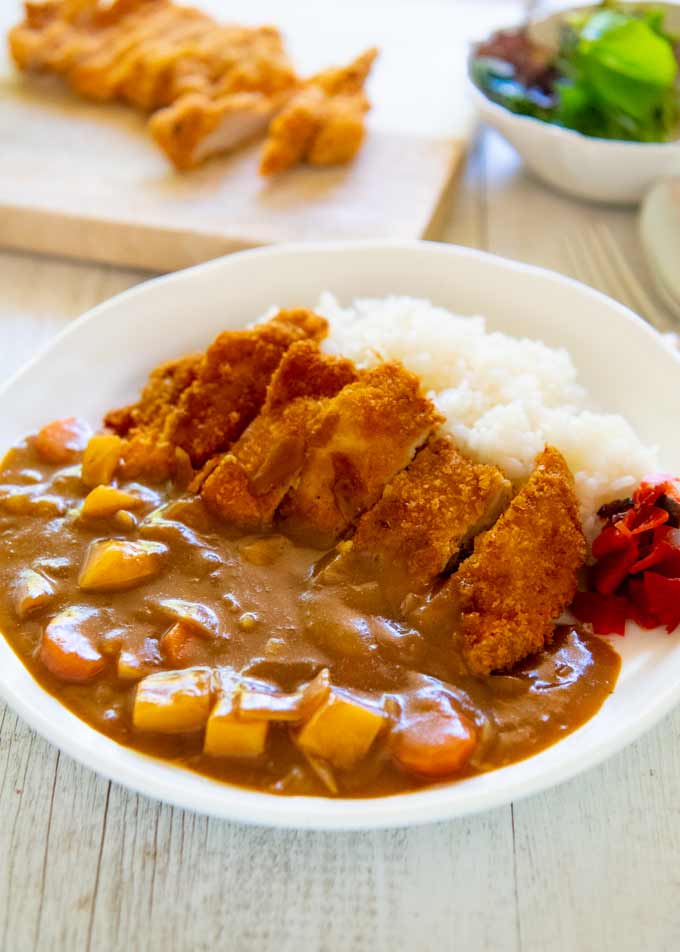
It is not an exaggeration to say that Japanese curry rice (カレーライス, pronounce it as ‘karē raisu’) is the national home cooking dish. When Japanese people say ‘having a curry tonight’, it is the Japanese curry that is made from the store-bought block of curry roux.
Not surprisingly, Katsu Curry is the most viewed recipe in my blog. So I decided to upgrade the post with a video.
Ready-made Curry Roux
The most popular store-bought curry roux in Japan is called Vermont Curry. It is one of the many curry roux products made by House Food Corporation. When you say ‘Vermont Curry’, everyone knows that it is House Vermont Curry.
The roux contains apple and honey to reduce the spiciness so that even little kids can eat curry.
Apparently, the name ‘Vermont’ came from the state of Vermont in the USA, which was known for folk medicine with apple cider vinegar and honey. At the time of the first TV commercial, this folk medicine was well known and popular, so House Foods just borrowed the name ‘Vermont’.
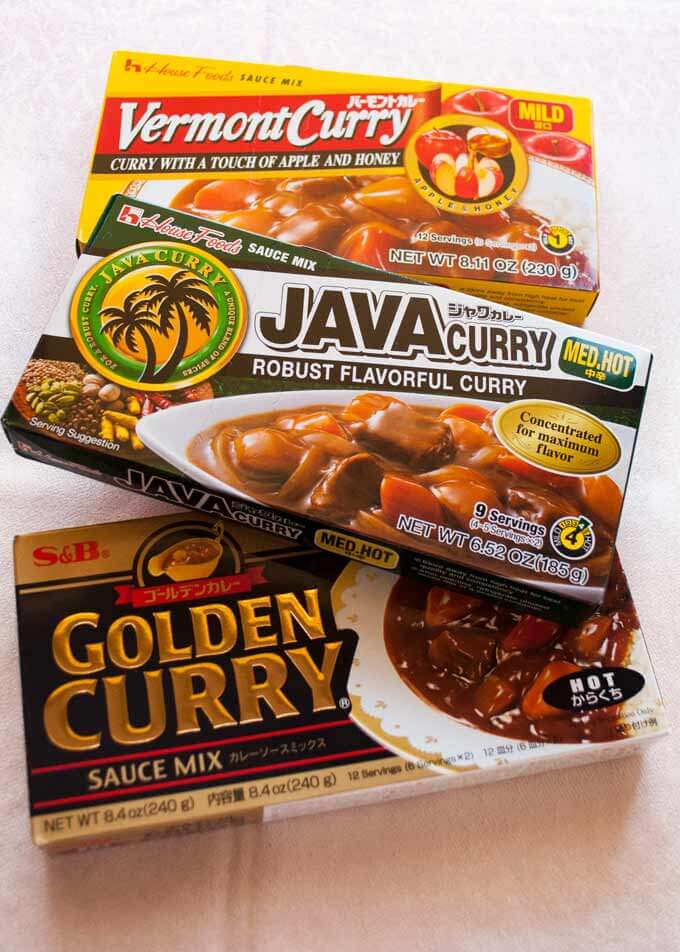
Many varieties of curry roux products are available now (see a few examples in photo above) and each household has its favourite curry roux. The roux makes the curry-making so easy. Sauté the meat and vegetables, add water and cook them, then add the roux. Viola!
You can buy Japanese curry roux at Japanese/Asian grocery stores as well as most supermarkets.
What’s in My Katsu Curry
Katsu Curry is simply a rice and curry with a cutlet on it. Since the cutlet is a meat dish on its own, my curry does not have any meat in it. I added three vegetables in the curry that are commonly used to make a Japanese Curry.
- House Vermont Curry (medium hot) – see the sample photo of the packet in the post
- Cooked rice
- Onion – sliced into 1cm wide pieces
- Potato – cut to 1.5cm / ⅝” cubes
- Carrot – sliced to 7mm / ¼” thick pieces
- Chicken Cutlet (Japanese Chicken Schnitzel) – cut into 2.5cm / 1″ wide strips
- Fukujinzuke as a condiment (if you have it)

The curry roux does not have to be Vermont Curry and the spiciness can be different too. It seems that supermarkets in Sydney do not stock House Vermont Curry. They sell S&B brand curry, so please use S&B brand curry instead.
The combination of the vegetables can also be changed. Some restaurants serve Katsu Curry with just a plain curry sauce, with no vegetables! I prefer not adding too many ingredients to the curry since the Chicken Cutlet is the hero of today’s dish.
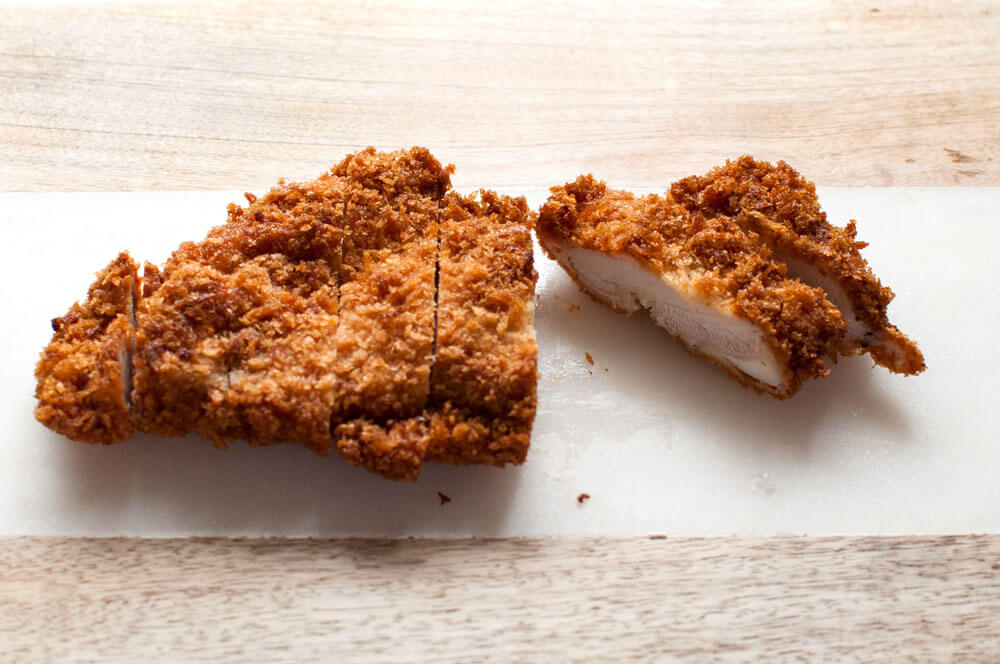
Instead of Chicken Cutlet, you can use pork cutlet. See my post Tonkatsu (Japanese Pork Schnitzel) for the recipe.
How to make Katsu Curry
If you are not using pre-made chicken cutlets, make curry first and make cutlets while cooking curry. I created a video for today’s recipe, which includes making of Chicken Cutlet, and the video shows exactly in this sequence.
- Put oil into a pot and sauté onion pieces until the edges start browning
- Add potato and carrot pieces to the pot and stir.
- Add water and bring it to a boil. Remove scum as it rises.
- Add curry roux and cook.
- Cook chicken cutlets and slice them.
- Put cooked rice on one side of a serving plate, place cutlet pieces next to the rice.
- Pour curry on the side next to the cutlet away from the rice.
- Place a small amount of fukujinzuke on the plate.
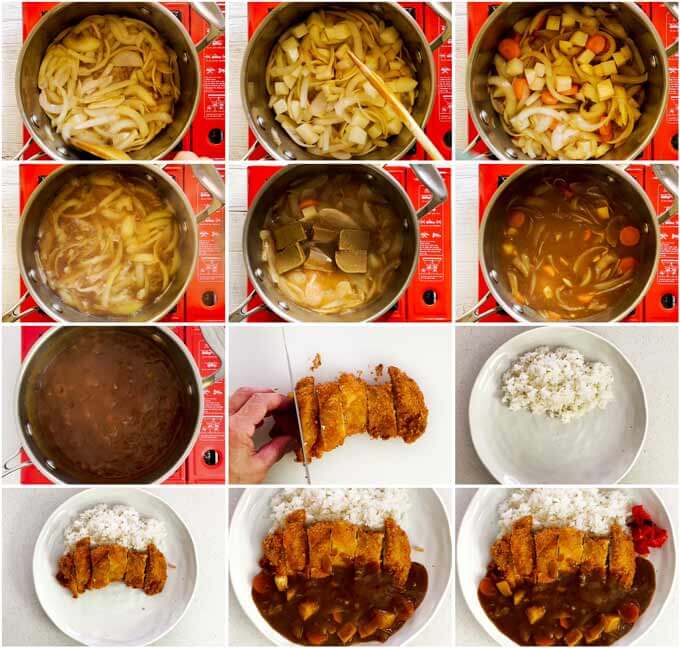
Depending on the brand of the curry roux, the amount of water required to make the right consistency of the curry varies. You need to read the instructions on the packet.
You will notice that the size of the vegetables in my recipe are not very large. This is because I wanted the cutlet to stand out even after pouring the curry on. Katsu curries served at restaurants often do not have anything in the sauce.
Katsu Curry – Great Pre-made Dish
You can store Japanese Curry for 2-3 days in the fridge and 1 month in freezer. But if you are freezing the curry, I strongly recommend avoiding adding potatoes to the curry. Defrosted potatoes become spongy, and the texture is not great.
When reheating the chilled curry, you may add some water to the curry because the roux thickens when cooled down. It still tastes great, though.
There are two ways to reheat frozen curry – heat in the microwave and heat in a hot water bath.
When reheating the curry in your microwave, stir from time to time. The outer part of the curry gets heated and even starts bubbling but often the centre is still frozen. You need to mix the hot and cold to speed up the process of defrosting and heating.
In the hot water bath method, you don’t need to worry about occasional mixing. Put the block of frozen curry in a zip lock bag and place it in a sieve that can go inside a pot of boiling water. The sieve prevents the plastic from touching the side of the pot, which is extremely hot.

Japanese curry is quite different in flavour and consistency from other authentic curries. The sauce is thicker than other curries in the world. It is similar to the consistency of béchamel sauce, and it is delicious!
Yumiko![]()
Watch How To Make It

Katsu curry is just a variation of Japanese curry with a Chicken Cutlet on top. I have used a store-bought block of Japanese curry roux, which is commonly used in Japanese households. The Chicken Cutlet brings the Japanese curry up to the next level. It’s so delicious and filling. (Watch the Video)
Time does not include the time required to make Chicken Cutlet
Don't forget to see the section 'MEAL IDEAS' below the recipe card! It gives you a list of dishes that I have already posted and this recipe that can make up a complete meal. I hope it is of help to you.
- 400g / 0.9lb onion sliced into 1cm / ⅜” wide pieces
- 250g / 0.6lb potato cut into 1.5cm / ⅝” cubes
- 100g / 3.5oz carrot sliced to 7mm / ¼” thick pieces (note 1)
- 1 tbsp oil
- ½ packet of 230g / 0.5lb House Vermont Curry (Mild, note 2)
- 800ml / 1.7pt water
- 4 cups cooked rice (hot)
- 4 Chicken Cutlets cut into 2.5cm / 1” wide strips (note 3)
- 4 tbsp fukujinzuke
-
Add oil to a pot and heat over medium high heat.
-
Add onion and sauté for a few minutes or until the onion becomes translucent and edges start getting slightly burnt.
-
Add potatoes and carrots into the pot and stir for a couple of minutes or until the surface of the vegetables starts getting cooked.
-
Add water and turn the heat up to bring it to a boil. Then reduce the heat to medium low and simmer for about 7 minutes or until the vegetables are nearly cooked through (note 4).
-
Break the curry roux cake into small blocks along the lines and add them into the pot. Stir gently to blend the curry roux.
-
Reduce the heat to low, place a lid on and cook for about 10 minutes or until the curry roux is completely dissolved. Stir occasionally as the curry tends to stick to the bottom of the pot.
-
Check the consistency of the sauce. It should be like béchamel sauce. If it's too thick, adjust with some water. If too thin, cook further without the lid. It will thicken when cooled down as well.
-
Turn the heat off.
-
Place a cup of hot cooked rice onto one side of a plate. Place the chicken cutlet pieces next to the rice, leaning them on the rice so that there will be a space to pour the curry.
-
Pour curry next to the chicken cutlet, put fukujinzuke on the side and serve immediately.
1. If the carrot is fat, you may halve or quarter it lengthwise, then slice it.
2. I used a medium-hot curry pack. But you can use mild, hot curry, or even another brand instead of House Food.
Different kinds/brands of roux might require different amounts of water. Please follow the instructions on the pack.
3. If you are making chicken cutlets at the same time, start making the cutlets when the water is added to the pot of curry ingredients so that the chicken cutlets are ready around the same time as the curry, or soon after the curry is done. It is better to use a freshly cooked hot chicken cutlets.
4. Put a skewer through the potato/carrot. If the skewer can easily get through, the vegetables are cooked.
5. You may pre-make the curry and serve it later. The curry can be kept for a few days in the fridge, 1 month in the freezer.
When the curry cools down, the sauce thickens. The consistency of the sauce should be like béchamel sauce. Check the consistency of the sauce after re-heating and if too thick, adjust with water.
To defrost your curry, see the post for two different methods.
6. Nutrition per serving. It is a high calorie food. Eat vegetables for the rest of the day!
serving: 790g calories: 945kcal fat: 45g (69%) saturated fat: 8.3g (42%) trans fat: 0.3g polyunsaturated fat: 9.6g monounsaturated fat: 24g cholesterol: 198mg (66%) sodium: 559mg (23%) potassium: 958mg (27%) carbohydrates: 93g (31%) dietary fibre: 6g (25%) sugar: 8g protein: 41g vitamin a: 88% vitamin c: 36% calcium: 10% iron: 31%
Originally published in March 2017, split into two posts to have Chicken Cutlet in a separate post, improved photos and contents with Meal Ideas in April 2020 (no change to recipe), improved contents with new photos and added video in December 2021.
Meal Ideas
A typical Japanese meal consists of a main dish, a couple of side dishes, a soup and rice. I try to come up with a combination of dishes with a variety of flavours, colours, textures and make-ahead dishes.
Fukujinzuke is the condiment to go with Japanese curry. I included it in today’s Meal Idea as you can make it at home, even if the recipe includes fukujinzuke.
I strongly recommend serving a salad to go with the rich flavour of the curry. Fresh or steamed salad with Mixed Vegetable Dressing would be perfect for it.
- Main: Katsu Curry (Japanese Curry with Chicken Cutlet) – today’s recipe, curry can be made ahead but freshly made Chicken Cutlet is recommended
- Side dish 1: Smoked Salmon with Grated Daikon Dressing (Mizore-ae) – or just a bowl of grated daikon with a bit of soy sauce or ponzu to be healthier
- Side dish 2: Mixed Vegetable Salad Dressing over either fresh salad/steamed vegetables – make ahead dressing
- Condiment: Home-made Fukujinzuke – make ahead
- Soup: Shimeji and Mizuna miso soup from Miso Soup Ingredient Combinations: or other ingredients of your choice
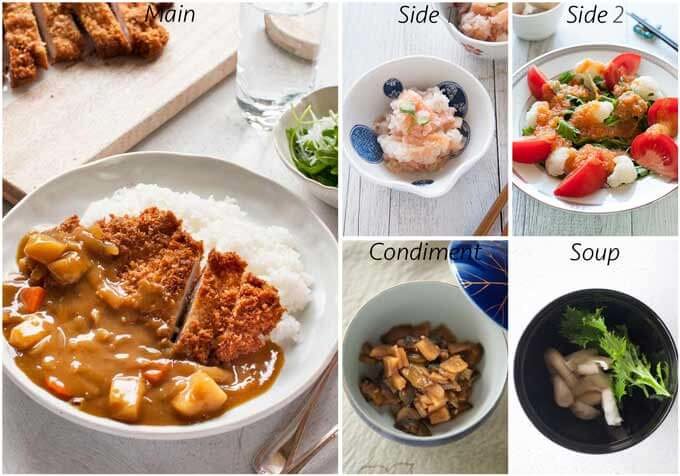
could you not just deep fry the chicken?
Hi James, you can shallow fry like schnitzel or oven bake by spraying oil over the breadcrumbs.Thy may not result in evenly browned crumbs on the surface and crunchiness might be different. But, these methods should still work.
I’m basically terrified of deep frying, but might be able to talk myself into an inch or two of oil. I’ve tried the oven-baked cutlets and, while they’re good, they’re not what I was looking for. Do you simply throw the oil away, after cooking the cutlets? (Yes, yes, in a can in the trash, not down the sink.)
Hi Chris, if I used the oil only once and the oil is still pretty clear, I used it again. I drain the oil into a can through a strainer with a filter paper (I buy some oils filtering paper at Daiso) on. Filtering removes crumbs and brown bits in the oil. But if a small amount of foil is used to fry large amount of food, the oil tends become brownish, in which case I throw away.
Thanks! I’ll give it a go.
Hi yumiko..this will be my first time making japanese curry and my first time using your recipe, I am a big fan of your daughter NAGI and her recipes..also a big fan of her crazy dog DOZER😄
CHEERS FROM GILLIAN👍
Hi Gillian, good luck with Japanese curry. Please let me know what you think.
im really looking forward to trying this and serving my friends! my only problem is i really want to include fukuzinjuke as well, which is hard to find in Australia even in the Asian groceries 🙁
Hi MM, you can buy fukujinzuke in Japanese grocery stores but as you say, Asian grocery stores probably don’t sell it. You can make it from scratch but I have not tried that. When I find time, I will attempt to make it and if successful, I will certainly post it!
This is a staple in our house. My kids love katsu curry. When I’m lazy and don’t want to make chicken katsu, I just brown the chicken in the pan with all the veggies and make it that way. I’ve never used the Vermont Curry before and bought it for the first time. I have to say it’s now a favorite of ours. I think it’s better than S&B Mild.
Hi Vanessa, it’s great to hear that Katsu Curry made to your staple food ranking.
We use the S & B brand of roux and love it. I never thought to add a chicken cutlet. Will have to try it now. I have an air fryer so will use it to fry my chicken. Thanks for the idea!
Hi Margaret, adding a cutlet brings the curry to another level in my view. It will be satisfying and very filling.
Hi! I’m Beatriz from Lima Peru. A few months ago I tried this dish in a restaurant and it was delicious, I´m fond of cooking and definitely I’ll try this recipe.
Hi Beatriz, please do try and let me know what you think of my version!
Thank you Yumiko, I simply adore Katsu Curry but find it is hard to get at local Japanese take a ways.
I will be shopping for the curry mix tomorrow and definitely will be making it as soon as possible. Once again thank you😀.
You are most welcome, Susanne!
My 18 year old son shared this recipe with me a couple months ago. We’ve tried chicken and pork cutlets and loved it both ways. Last time we used pork and added cubed tenderloin steak to the curry. Amazing!! We’re making the same again tonight and can’t wait. The recipe is easy to follow and it turns out great every time.
Hi Laureen, I love katsu curry and so do all my kids. Your son must be a keen eater. Reading your comment, I feel like making katsu curry today for myself!
Hello yumiko, today I tried this recipe, but I omitted the breaded chicken since I wanted to try the Vermont curry (I had previously tried S & B curry) however, I found it a bit simple … I do not think it lacked a bit of spice flavor Will I have done something wrong or the taste of this brand is softer? I have read that in Japan the curry that can be eaten in a restaurant has more flavor, is it true?
It’s also quite weird because my mom liked curry XD
Hi Ruth, I don’t think you did anything wrong with the curry. Vermont curry tends to be on mild side compared to S&B. That’s why the families with young children in Japan favour it over other brands. The curry at restaurants are usually made from scratch (pre-made curry roux cannot compete against home-made!) and as you noted, they are in general more spicy.
I made this tonight! I was so excited! I loved It! I love curry, my husband isn’t a big fan but he loved it too! I feel like this will be one of our staple dishes now.
That’s great, Frances. Thank you for a good feedback!
Made this tonight, was amazing. My 5 year old who is normally quite fussy asked me to make it again!
Hi Natalie, thank you! Nothing is better than getting asked to cook again by your family, isn’t it?